Tesco PLC: Brand Equity, International Marketing Strategy Report
VerifiedAdded on 2021/05/30
|19
|4148
|37
Report
AI Summary
This report provides an analysis of Tesco PLC's marketing principles and practices, focusing on brand equity and international marketing strategies. It examines Tesco's brand recognition, identity, positioning, and personality using Keller's Brand Equity Model and Aaker's Model. The report also explores Tesco's international marketing approach, highlighting the GLOCAL strategy (Go Global and Think Local) and the EPRG framework. Furthermore, it discusses standardization versus adaptation in the marketing mix and the application of the Glocalization concept using the Hollensen Model. The report concludes by emphasizing Tesco's success in the UK and European markets, while noting the need for strategic differentiation in the Asian market. Desklib offers a wealth of similar solved assignments and study resources for students.
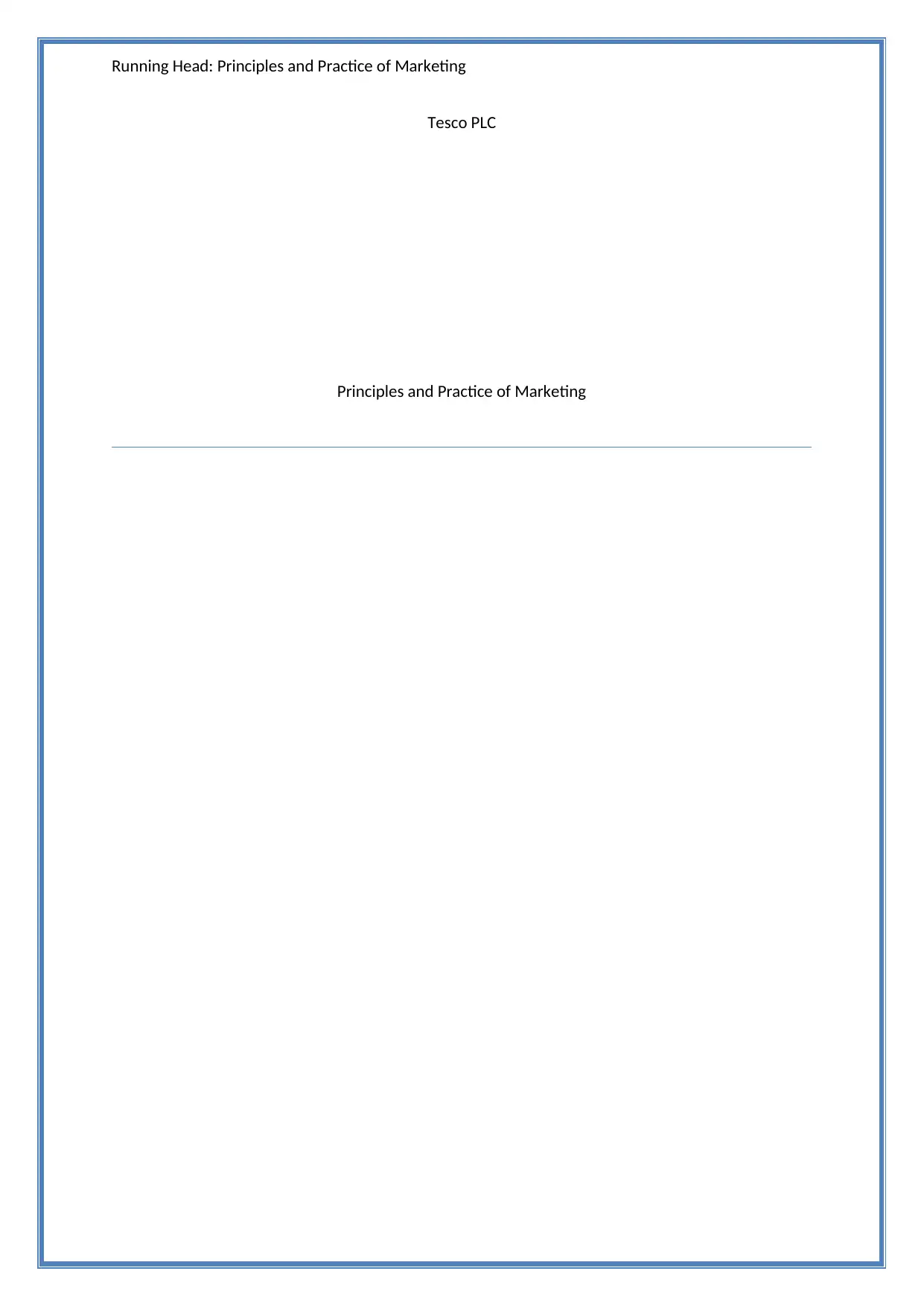
Running Head: Principles and Practice of Marketing
Tesco PLC
Principles and Practice of Marketing
Tesco PLC
Principles and Practice of Marketing
Paraphrase This Document
Need a fresh take? Get an instant paraphrase of this document with our AI Paraphraser
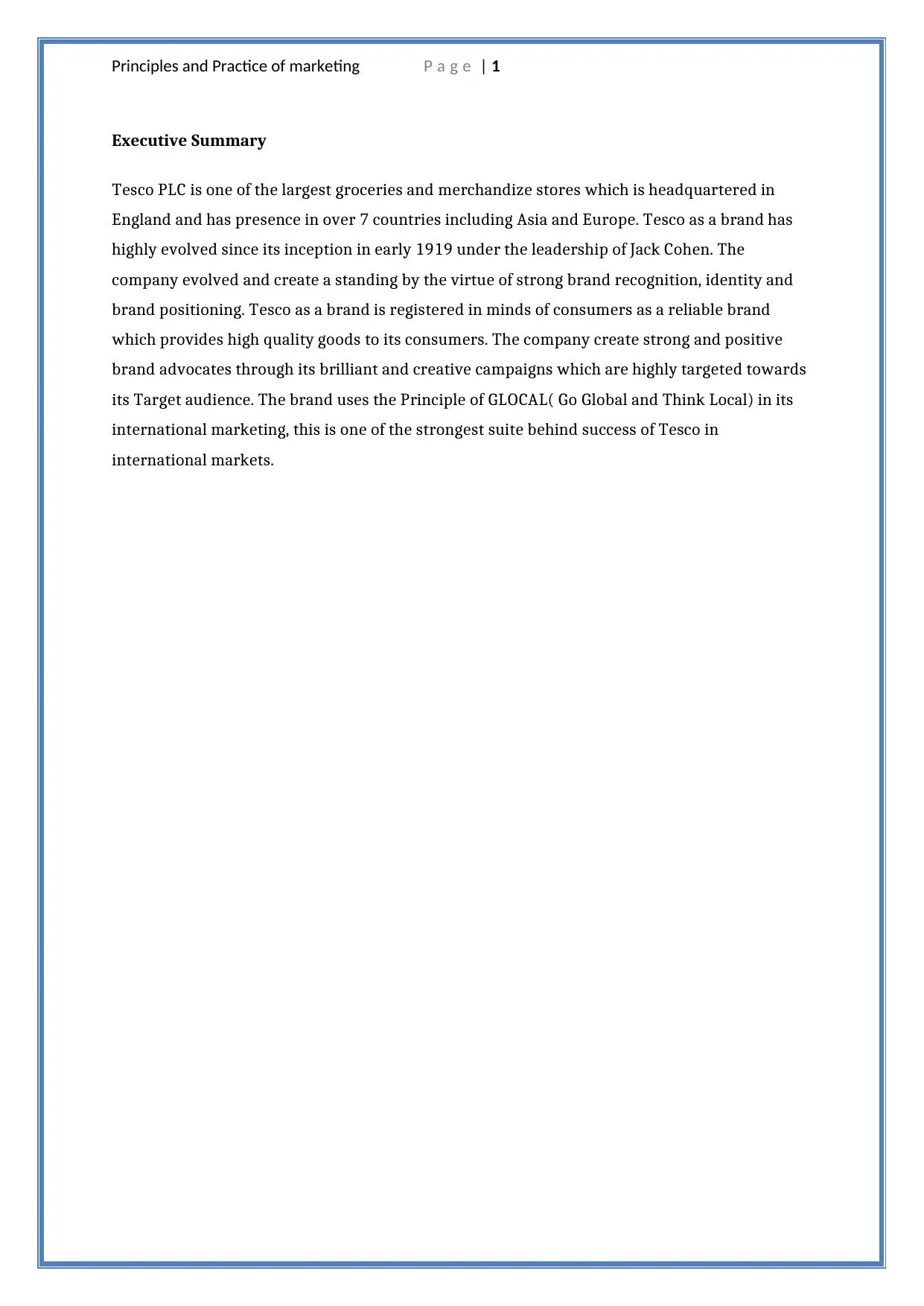
Principles and Practice of marketing P a g e | 1
Executive Summary
Tesco PLC is one of the largest groceries and merchandize stores which is headquartered in
England and has presence in over 7 countries including Asia and Europe. Tesco as a brand has
highly evolved since its inception in early 1919 under the leadership of Jack Cohen. The
company evolved and create a standing by the virtue of strong brand recognition, identity and
brand positioning. Tesco as a brand is registered in minds of consumers as a reliable brand
which provides high quality goods to its consumers. The company create strong and positive
brand advocates through its brilliant and creative campaigns which are highly targeted towards
its Target audience. The brand uses the Principle of GLOCAL( Go Global and Think Local) in its
international marketing, this is one of the strongest suite behind success of Tesco in
international markets.
Executive Summary
Tesco PLC is one of the largest groceries and merchandize stores which is headquartered in
England and has presence in over 7 countries including Asia and Europe. Tesco as a brand has
highly evolved since its inception in early 1919 under the leadership of Jack Cohen. The
company evolved and create a standing by the virtue of strong brand recognition, identity and
brand positioning. Tesco as a brand is registered in minds of consumers as a reliable brand
which provides high quality goods to its consumers. The company create strong and positive
brand advocates through its brilliant and creative campaigns which are highly targeted towards
its Target audience. The brand uses the Principle of GLOCAL( Go Global and Think Local) in its
international marketing, this is one of the strongest suite behind success of Tesco in
international markets.
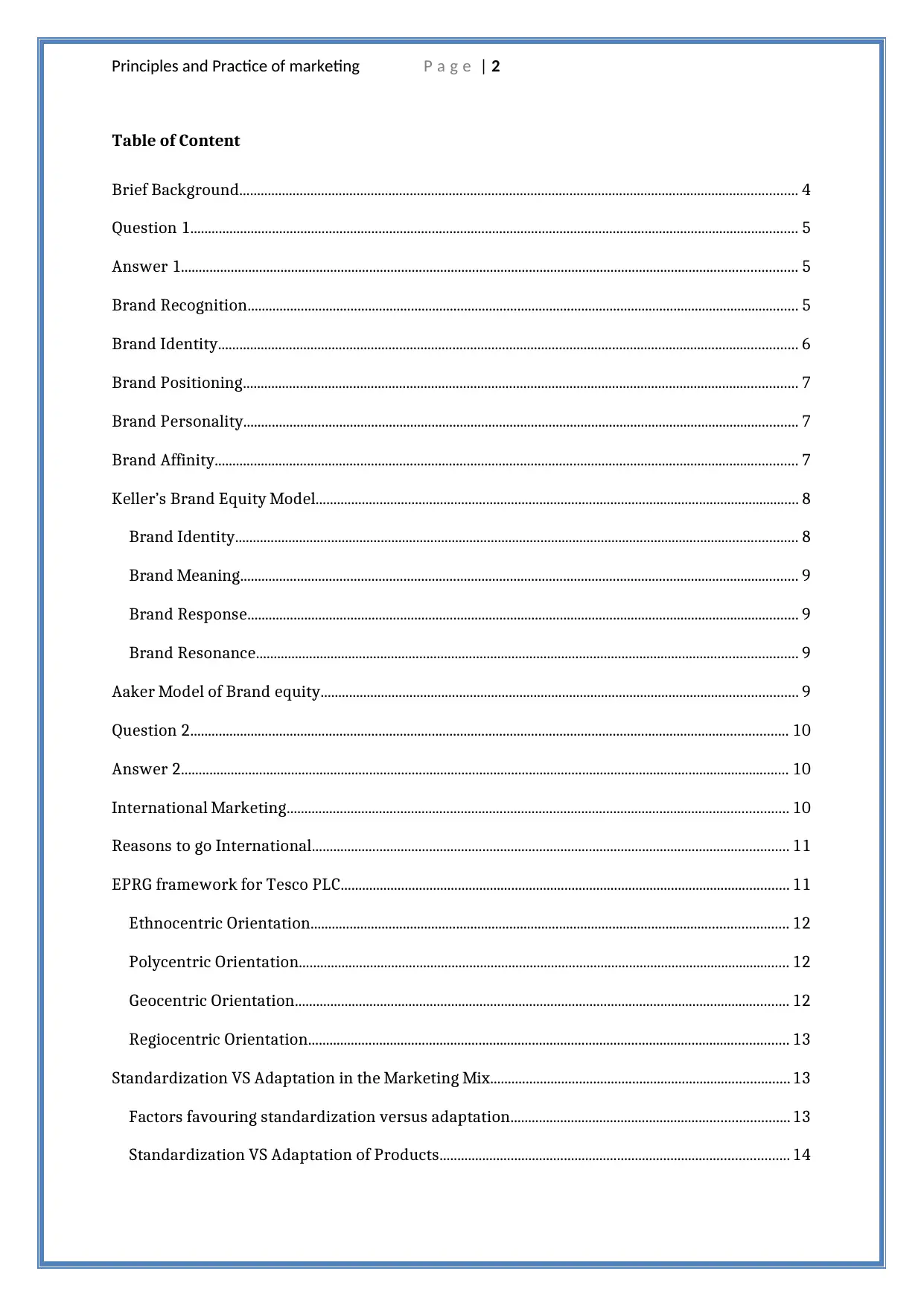
Principles and Practice of marketing P a g e | 2
Table of Content
Brief Background............................................................................................................................................................. 4
Question 1........................................................................................................................................................................... 5
Answer 1............................................................................................................................................................................. 5
Brand Recognition........................................................................................................................................................... 5
Brand Identity................................................................................................................................................................... 6
Brand Positioning............................................................................................................................................................ 7
Brand Personality............................................................................................................................................................ 7
Brand Affinity.................................................................................................................................................................... 7
Keller’s Brand Equity Model........................................................................................................................................ 8
Brand Identity.............................................................................................................................................................. 8
Brand Meaning............................................................................................................................................................. 9
Brand Response........................................................................................................................................................... 9
Brand Resonance........................................................................................................................................................ 9
Aaker Model of Brand equity...................................................................................................................................... 9
Question 2........................................................................................................................................................................ 10
Answer 2........................................................................................................................................................................... 10
International Marketing............................................................................................................................................. 10
Reasons to go International...................................................................................................................................... 11
EPRG framework for Tesco PLC.............................................................................................................................. 11
Ethnocentric Orientation...................................................................................................................................... 12
Polycentric Orientation.......................................................................................................................................... 12
Geocentric Orientation........................................................................................................................................... 12
Regiocentric Orientation....................................................................................................................................... 13
Standardization VS Adaptation in the Marketing Mix....................................................................................13
Factors favouring standardization versus adaptation..............................................................................13
Standardization VS Adaptation of Products.................................................................................................. 14
Table of Content
Brief Background............................................................................................................................................................. 4
Question 1........................................................................................................................................................................... 5
Answer 1............................................................................................................................................................................. 5
Brand Recognition........................................................................................................................................................... 5
Brand Identity................................................................................................................................................................... 6
Brand Positioning............................................................................................................................................................ 7
Brand Personality............................................................................................................................................................ 7
Brand Affinity.................................................................................................................................................................... 7
Keller’s Brand Equity Model........................................................................................................................................ 8
Brand Identity.............................................................................................................................................................. 8
Brand Meaning............................................................................................................................................................. 9
Brand Response........................................................................................................................................................... 9
Brand Resonance........................................................................................................................................................ 9
Aaker Model of Brand equity...................................................................................................................................... 9
Question 2........................................................................................................................................................................ 10
Answer 2........................................................................................................................................................................... 10
International Marketing............................................................................................................................................. 10
Reasons to go International...................................................................................................................................... 11
EPRG framework for Tesco PLC.............................................................................................................................. 11
Ethnocentric Orientation...................................................................................................................................... 12
Polycentric Orientation.......................................................................................................................................... 12
Geocentric Orientation........................................................................................................................................... 12
Regiocentric Orientation....................................................................................................................................... 13
Standardization VS Adaptation in the Marketing Mix....................................................................................13
Factors favouring standardization versus adaptation..............................................................................13
Standardization VS Adaptation of Products.................................................................................................. 14
⊘ This is a preview!⊘
Do you want full access?
Subscribe today to unlock all pages.

Trusted by 1+ million students worldwide
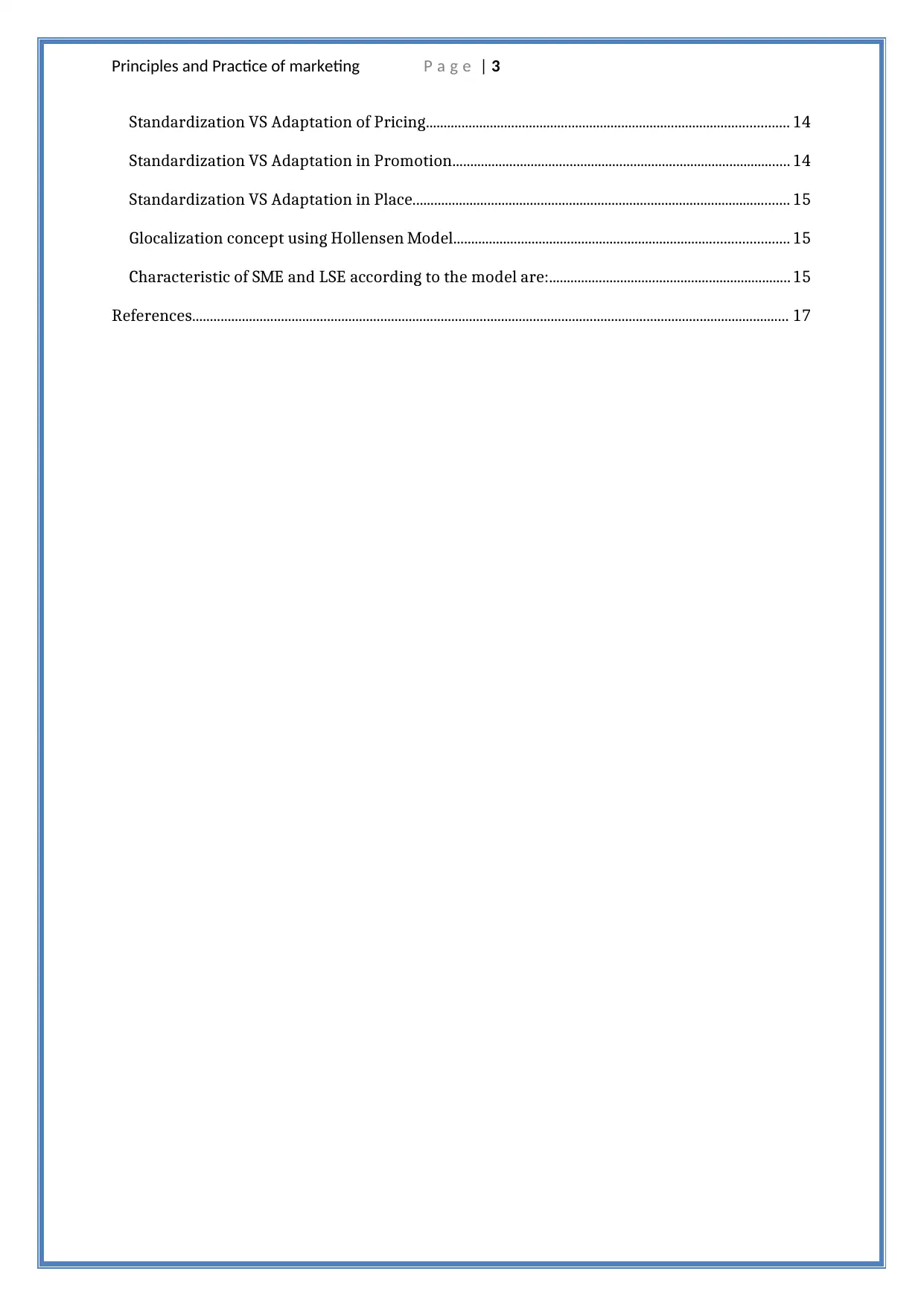
Principles and Practice of marketing P a g e | 3
Standardization VS Adaptation of Pricing...................................................................................................... 14
Standardization VS Adaptation in Promotion............................................................................................... 14
Standardization VS Adaptation in Place.......................................................................................................... 15
Glocalization concept using Hollensen Model.............................................................................................. 15
Characteristic of SME and LSE according to the model are:....................................................................15
References........................................................................................................................................................................ 17
Standardization VS Adaptation of Pricing...................................................................................................... 14
Standardization VS Adaptation in Promotion............................................................................................... 14
Standardization VS Adaptation in Place.......................................................................................................... 15
Glocalization concept using Hollensen Model.............................................................................................. 15
Characteristic of SME and LSE according to the model are:....................................................................15
References........................................................................................................................................................................ 17
Paraphrase This Document
Need a fresh take? Get an instant paraphrase of this document with our AI Paraphraser
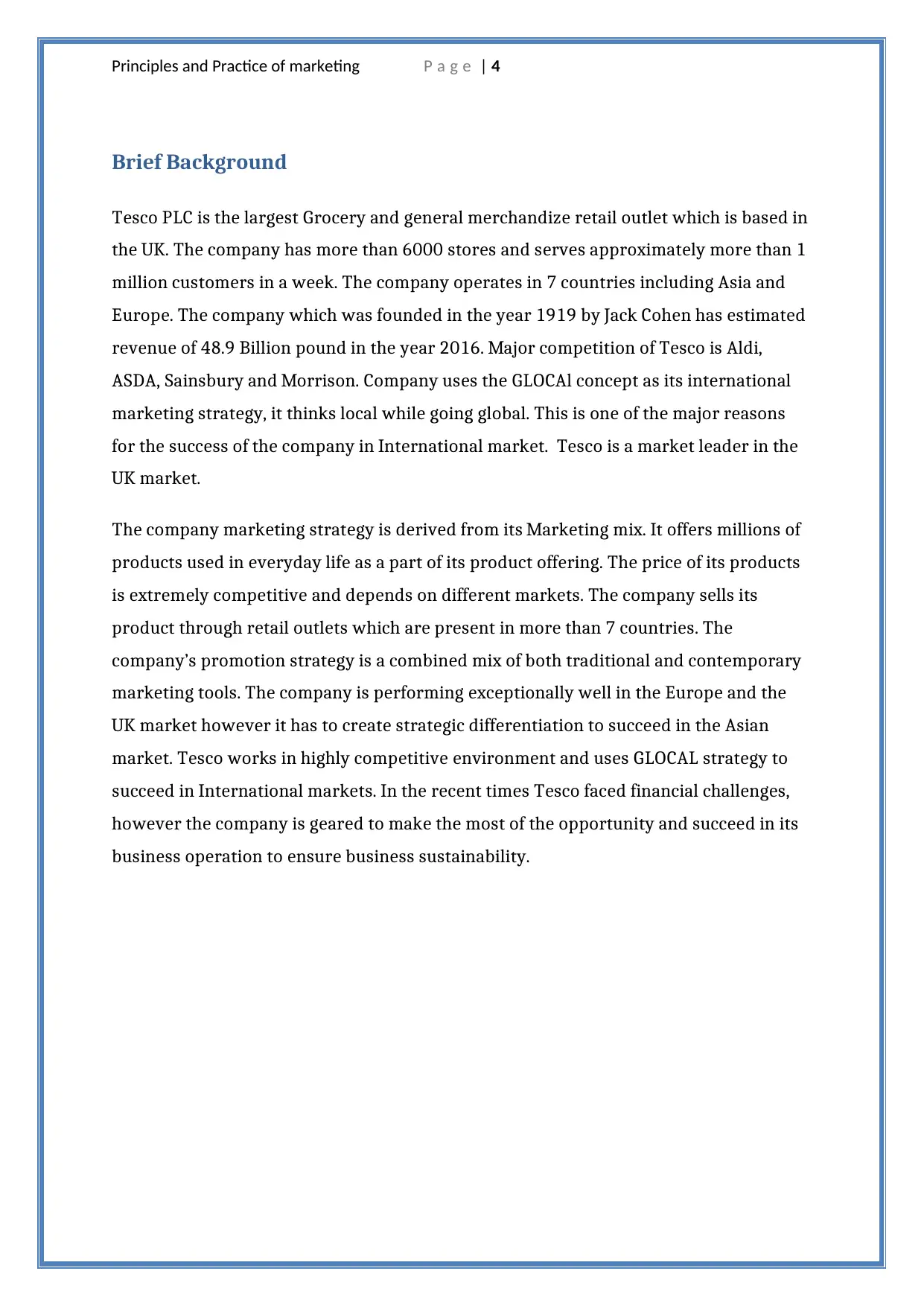
Principles and Practice of marketing P a g e | 4
Brief Background
Tesco PLC is the largest Grocery and general merchandize retail outlet which is based in
the UK. The company has more than 6000 stores and serves approximately more than 1
million customers in a week. The company operates in 7 countries including Asia and
Europe. The company which was founded in the year 1919 by Jack Cohen has estimated
revenue of 48.9 Billion pound in the year 2016. Major competition of Tesco is Aldi,
ASDA, Sainsbury and Morrison. Company uses the GLOCAl concept as its international
marketing strategy, it thinks local while going global. This is one of the major reasons
for the success of the company in International market. Tesco is a market leader in the
UK market.
The company marketing strategy is derived from its Marketing mix. It offers millions of
products used in everyday life as a part of its product offering. The price of its products
is extremely competitive and depends on different markets. The company sells its
product through retail outlets which are present in more than 7 countries. The
company’s promotion strategy is a combined mix of both traditional and contemporary
marketing tools. The company is performing exceptionally well in the Europe and the
UK market however it has to create strategic differentiation to succeed in the Asian
market. Tesco works in highly competitive environment and uses GLOCAL strategy to
succeed in International markets. In the recent times Tesco faced financial challenges,
however the company is geared to make the most of the opportunity and succeed in its
business operation to ensure business sustainability.
Brief Background
Tesco PLC is the largest Grocery and general merchandize retail outlet which is based in
the UK. The company has more than 6000 stores and serves approximately more than 1
million customers in a week. The company operates in 7 countries including Asia and
Europe. The company which was founded in the year 1919 by Jack Cohen has estimated
revenue of 48.9 Billion pound in the year 2016. Major competition of Tesco is Aldi,
ASDA, Sainsbury and Morrison. Company uses the GLOCAl concept as its international
marketing strategy, it thinks local while going global. This is one of the major reasons
for the success of the company in International market. Tesco is a market leader in the
UK market.
The company marketing strategy is derived from its Marketing mix. It offers millions of
products used in everyday life as a part of its product offering. The price of its products
is extremely competitive and depends on different markets. The company sells its
product through retail outlets which are present in more than 7 countries. The
company’s promotion strategy is a combined mix of both traditional and contemporary
marketing tools. The company is performing exceptionally well in the Europe and the
UK market however it has to create strategic differentiation to succeed in the Asian
market. Tesco works in highly competitive environment and uses GLOCAL strategy to
succeed in International markets. In the recent times Tesco faced financial challenges,
however the company is geared to make the most of the opportunity and succeed in its
business operation to ensure business sustainability.
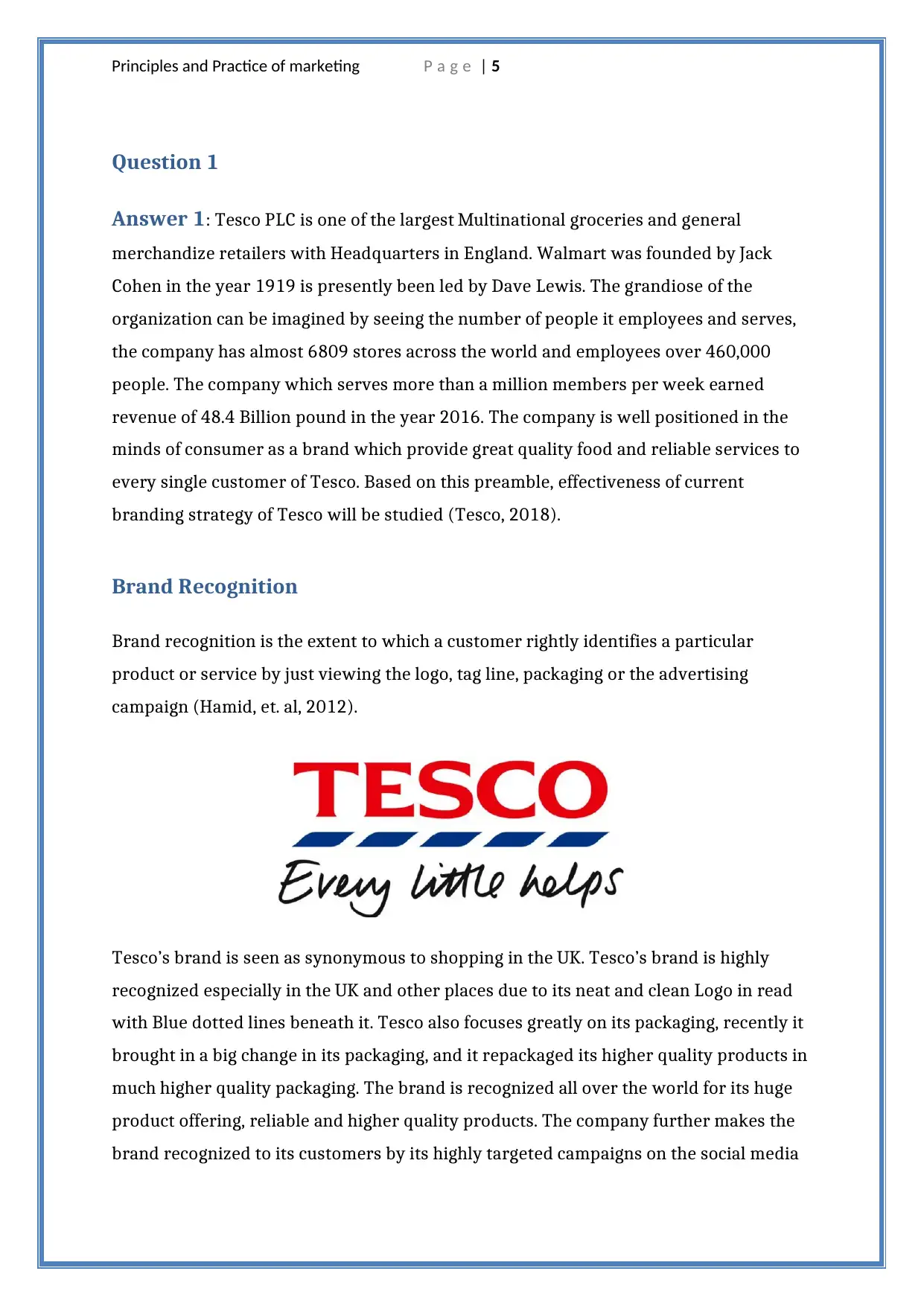
Principles and Practice of marketing P a g e | 5
Question 1
Answer 1: Tesco PLC is one of the largest Multinational groceries and general
merchandize retailers with Headquarters in England. Walmart was founded by Jack
Cohen in the year 1919 is presently been led by Dave Lewis. The grandiose of the
organization can be imagined by seeing the number of people it employees and serves,
the company has almost 6809 stores across the world and employees over 460,000
people. The company which serves more than a million members per week earned
revenue of 48.4 Billion pound in the year 2016. The company is well positioned in the
minds of consumer as a brand which provide great quality food and reliable services to
every single customer of Tesco. Based on this preamble, effectiveness of current
branding strategy of Tesco will be studied (Tesco, 2018).
Brand Recognition
Brand recognition is the extent to which a customer rightly identifies a particular
product or service by just viewing the logo, tag line, packaging or the advertising
campaign (Hamid, et. al, 2012).
Tesco’s brand is seen as synonymous to shopping in the UK. Tesco’s brand is highly
recognized especially in the UK and other places due to its neat and clean Logo in read
with Blue dotted lines beneath it. Tesco also focuses greatly on its packaging, recently it
brought in a big change in its packaging, and it repackaged its higher quality products in
much higher quality packaging. The brand is recognized all over the world for its huge
product offering, reliable and higher quality products. The company further makes the
brand recognized to its customers by its highly targeted campaigns on the social media
Question 1
Answer 1: Tesco PLC is one of the largest Multinational groceries and general
merchandize retailers with Headquarters in England. Walmart was founded by Jack
Cohen in the year 1919 is presently been led by Dave Lewis. The grandiose of the
organization can be imagined by seeing the number of people it employees and serves,
the company has almost 6809 stores across the world and employees over 460,000
people. The company which serves more than a million members per week earned
revenue of 48.4 Billion pound in the year 2016. The company is well positioned in the
minds of consumer as a brand which provide great quality food and reliable services to
every single customer of Tesco. Based on this preamble, effectiveness of current
branding strategy of Tesco will be studied (Tesco, 2018).
Brand Recognition
Brand recognition is the extent to which a customer rightly identifies a particular
product or service by just viewing the logo, tag line, packaging or the advertising
campaign (Hamid, et. al, 2012).
Tesco’s brand is seen as synonymous to shopping in the UK. Tesco’s brand is highly
recognized especially in the UK and other places due to its neat and clean Logo in read
with Blue dotted lines beneath it. Tesco also focuses greatly on its packaging, recently it
brought in a big change in its packaging, and it repackaged its higher quality products in
much higher quality packaging. The brand is recognized all over the world for its huge
product offering, reliable and higher quality products. The company further makes the
brand recognized to its customers by its highly targeted campaigns on the social media
⊘ This is a preview!⊘
Do you want full access?
Subscribe today to unlock all pages.

Trusted by 1+ million students worldwide
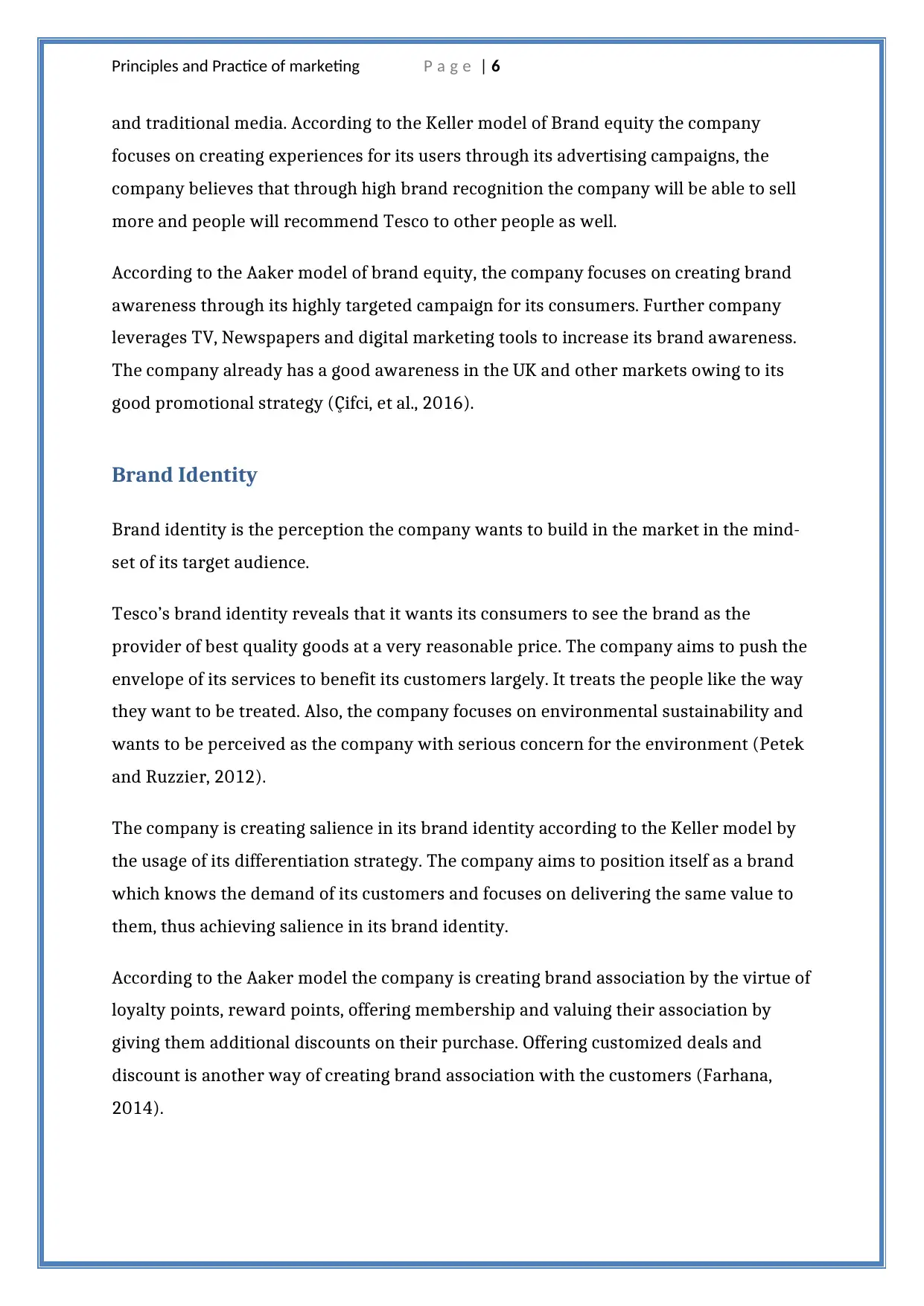
Principles and Practice of marketing P a g e | 6
and traditional media. According to the Keller model of Brand equity the company
focuses on creating experiences for its users through its advertising campaigns, the
company believes that through high brand recognition the company will be able to sell
more and people will recommend Tesco to other people as well.
According to the Aaker model of brand equity, the company focuses on creating brand
awareness through its highly targeted campaign for its consumers. Further company
leverages TV, Newspapers and digital marketing tools to increase its brand awareness.
The company already has a good awareness in the UK and other markets owing to its
good promotional strategy (Çifci, et al., 2016).
Brand Identity
Brand identity is the perception the company wants to build in the market in the mind-
set of its target audience.
Tesco’s brand identity reveals that it wants its consumers to see the brand as the
provider of best quality goods at a very reasonable price. The company aims to push the
envelope of its services to benefit its customers largely. It treats the people like the way
they want to be treated. Also, the company focuses on environmental sustainability and
wants to be perceived as the company with serious concern for the environment (Petek
and Ruzzier, 2012).
The company is creating salience in its brand identity according to the Keller model by
the usage of its differentiation strategy. The company aims to position itself as a brand
which knows the demand of its customers and focuses on delivering the same value to
them, thus achieving salience in its brand identity.
According to the Aaker model the company is creating brand association by the virtue of
loyalty points, reward points, offering membership and valuing their association by
giving them additional discounts on their purchase. Offering customized deals and
discount is another way of creating brand association with the customers (Farhana,
2014).
and traditional media. According to the Keller model of Brand equity the company
focuses on creating experiences for its users through its advertising campaigns, the
company believes that through high brand recognition the company will be able to sell
more and people will recommend Tesco to other people as well.
According to the Aaker model of brand equity, the company focuses on creating brand
awareness through its highly targeted campaign for its consumers. Further company
leverages TV, Newspapers and digital marketing tools to increase its brand awareness.
The company already has a good awareness in the UK and other markets owing to its
good promotional strategy (Çifci, et al., 2016).
Brand Identity
Brand identity is the perception the company wants to build in the market in the mind-
set of its target audience.
Tesco’s brand identity reveals that it wants its consumers to see the brand as the
provider of best quality goods at a very reasonable price. The company aims to push the
envelope of its services to benefit its customers largely. It treats the people like the way
they want to be treated. Also, the company focuses on environmental sustainability and
wants to be perceived as the company with serious concern for the environment (Petek
and Ruzzier, 2012).
The company is creating salience in its brand identity according to the Keller model by
the usage of its differentiation strategy. The company aims to position itself as a brand
which knows the demand of its customers and focuses on delivering the same value to
them, thus achieving salience in its brand identity.
According to the Aaker model the company is creating brand association by the virtue of
loyalty points, reward points, offering membership and valuing their association by
giving them additional discounts on their purchase. Offering customized deals and
discount is another way of creating brand association with the customers (Farhana,
2014).
Paraphrase This Document
Need a fresh take? Get an instant paraphrase of this document with our AI Paraphraser
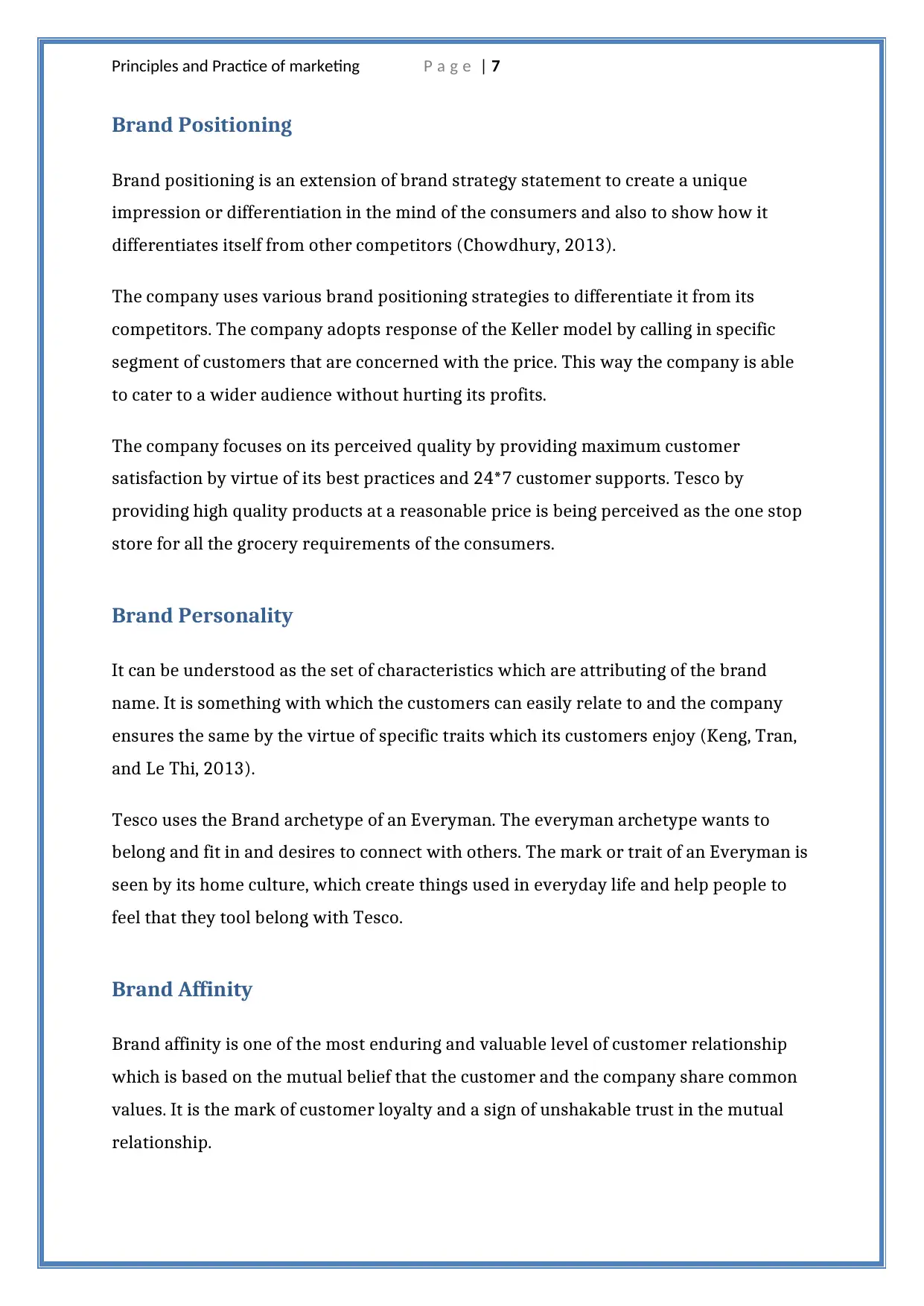
Principles and Practice of marketing P a g e | 7
Brand Positioning
Brand positioning is an extension of brand strategy statement to create a unique
impression or differentiation in the mind of the consumers and also to show how it
differentiates itself from other competitors (Chowdhury, 2013).
The company uses various brand positioning strategies to differentiate it from its
competitors. The company adopts response of the Keller model by calling in specific
segment of customers that are concerned with the price. This way the company is able
to cater to a wider audience without hurting its profits.
The company focuses on its perceived quality by providing maximum customer
satisfaction by virtue of its best practices and 24*7 customer supports. Tesco by
providing high quality products at a reasonable price is being perceived as the one stop
store for all the grocery requirements of the consumers.
Brand Personality
It can be understood as the set of characteristics which are attributing of the brand
name. It is something with which the customers can easily relate to and the company
ensures the same by the virtue of specific traits which its customers enjoy (Keng, Tran,
and Le Thi, 2013).
Tesco uses the Brand archetype of an Everyman. The everyman archetype wants to
belong and fit in and desires to connect with others. The mark or trait of an Everyman is
seen by its home culture, which create things used in everyday life and help people to
feel that they tool belong with Tesco.
Brand Affinity
Brand affinity is one of the most enduring and valuable level of customer relationship
which is based on the mutual belief that the customer and the company share common
values. It is the mark of customer loyalty and a sign of unshakable trust in the mutual
relationship.
Brand Positioning
Brand positioning is an extension of brand strategy statement to create a unique
impression or differentiation in the mind of the consumers and also to show how it
differentiates itself from other competitors (Chowdhury, 2013).
The company uses various brand positioning strategies to differentiate it from its
competitors. The company adopts response of the Keller model by calling in specific
segment of customers that are concerned with the price. This way the company is able
to cater to a wider audience without hurting its profits.
The company focuses on its perceived quality by providing maximum customer
satisfaction by virtue of its best practices and 24*7 customer supports. Tesco by
providing high quality products at a reasonable price is being perceived as the one stop
store for all the grocery requirements of the consumers.
Brand Personality
It can be understood as the set of characteristics which are attributing of the brand
name. It is something with which the customers can easily relate to and the company
ensures the same by the virtue of specific traits which its customers enjoy (Keng, Tran,
and Le Thi, 2013).
Tesco uses the Brand archetype of an Everyman. The everyman archetype wants to
belong and fit in and desires to connect with others. The mark or trait of an Everyman is
seen by its home culture, which create things used in everyday life and help people to
feel that they tool belong with Tesco.
Brand Affinity
Brand affinity is one of the most enduring and valuable level of customer relationship
which is based on the mutual belief that the customer and the company share common
values. It is the mark of customer loyalty and a sign of unshakable trust in the mutual
relationship.
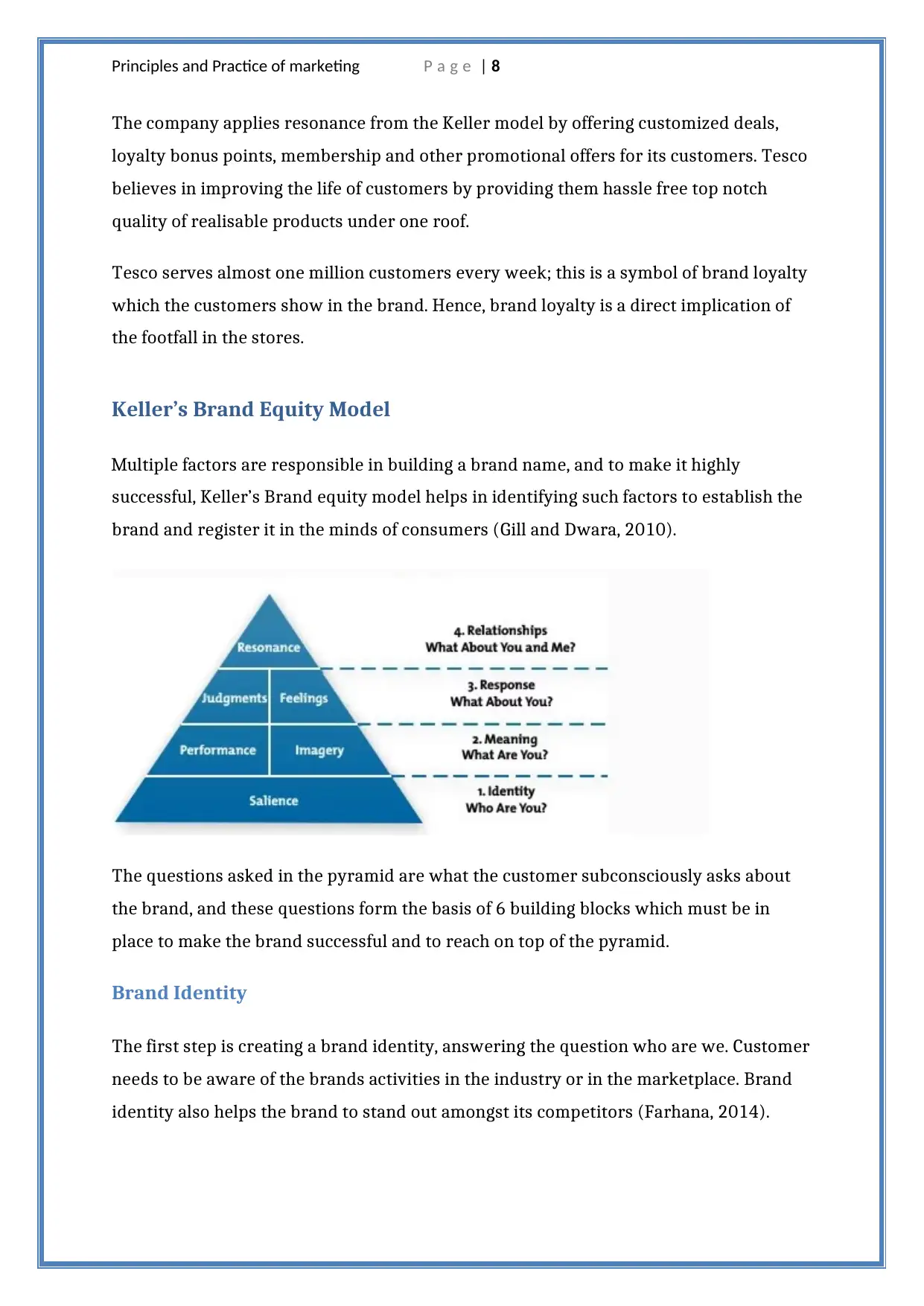
Principles and Practice of marketing P a g e | 8
The company applies resonance from the Keller model by offering customized deals,
loyalty bonus points, membership and other promotional offers for its customers. Tesco
believes in improving the life of customers by providing them hassle free top notch
quality of realisable products under one roof.
Tesco serves almost one million customers every week; this is a symbol of brand loyalty
which the customers show in the brand. Hence, brand loyalty is a direct implication of
the footfall in the stores.
Keller’s Brand Equity Model
Multiple factors are responsible in building a brand name, and to make it highly
successful, Keller’s Brand equity model helps in identifying such factors to establish the
brand and register it in the minds of consumers (Gill and Dwara, 2010).
The questions asked in the pyramid are what the customer subconsciously asks about
the brand, and these questions form the basis of 6 building blocks which must be in
place to make the brand successful and to reach on top of the pyramid.
Brand Identity
The first step is creating a brand identity, answering the question who are we. Customer
needs to be aware of the brands activities in the industry or in the marketplace. Brand
identity also helps the brand to stand out amongst its competitors (Farhana, 2014).
The company applies resonance from the Keller model by offering customized deals,
loyalty bonus points, membership and other promotional offers for its customers. Tesco
believes in improving the life of customers by providing them hassle free top notch
quality of realisable products under one roof.
Tesco serves almost one million customers every week; this is a symbol of brand loyalty
which the customers show in the brand. Hence, brand loyalty is a direct implication of
the footfall in the stores.
Keller’s Brand Equity Model
Multiple factors are responsible in building a brand name, and to make it highly
successful, Keller’s Brand equity model helps in identifying such factors to establish the
brand and register it in the minds of consumers (Gill and Dwara, 2010).
The questions asked in the pyramid are what the customer subconsciously asks about
the brand, and these questions form the basis of 6 building blocks which must be in
place to make the brand successful and to reach on top of the pyramid.
Brand Identity
The first step is creating a brand identity, answering the question who are we. Customer
needs to be aware of the brands activities in the industry or in the marketplace. Brand
identity also helps the brand to stand out amongst its competitors (Farhana, 2014).
⊘ This is a preview!⊘
Do you want full access?
Subscribe today to unlock all pages.

Trusted by 1+ million students worldwide
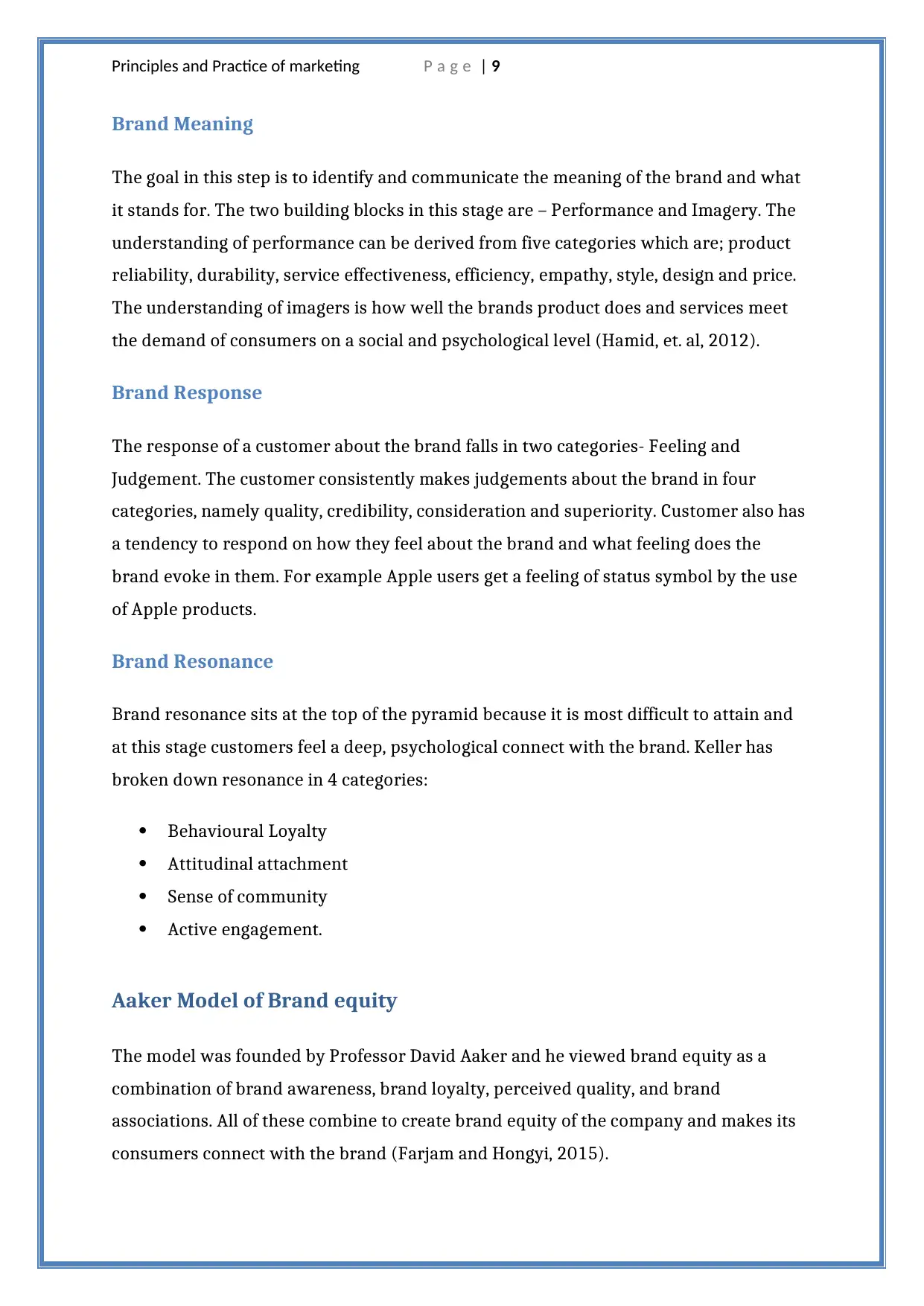
Principles and Practice of marketing P a g e | 9
Brand Meaning
The goal in this step is to identify and communicate the meaning of the brand and what
it stands for. The two building blocks in this stage are – Performance and Imagery. The
understanding of performance can be derived from five categories which are; product
reliability, durability, service effectiveness, efficiency, empathy, style, design and price.
The understanding of imagers is how well the brands product does and services meet
the demand of consumers on a social and psychological level (Hamid, et. al, 2012).
Brand Response
The response of a customer about the brand falls in two categories- Feeling and
Judgement. The customer consistently makes judgements about the brand in four
categories, namely quality, credibility, consideration and superiority. Customer also has
a tendency to respond on how they feel about the brand and what feeling does the
brand evoke in them. For example Apple users get a feeling of status symbol by the use
of Apple products.
Brand Resonance
Brand resonance sits at the top of the pyramid because it is most difficult to attain and
at this stage customers feel a deep, psychological connect with the brand. Keller has
broken down resonance in 4 categories:
Behavioural Loyalty
Attitudinal attachment
Sense of community
Active engagement.
Aaker Model of Brand equity
The model was founded by Professor David Aaker and he viewed brand equity as a
combination of brand awareness, brand loyalty, perceived quality, and brand
associations. All of these combine to create brand equity of the company and makes its
consumers connect with the brand (Farjam and Hongyi, 2015).
Brand Meaning
The goal in this step is to identify and communicate the meaning of the brand and what
it stands for. The two building blocks in this stage are – Performance and Imagery. The
understanding of performance can be derived from five categories which are; product
reliability, durability, service effectiveness, efficiency, empathy, style, design and price.
The understanding of imagers is how well the brands product does and services meet
the demand of consumers on a social and psychological level (Hamid, et. al, 2012).
Brand Response
The response of a customer about the brand falls in two categories- Feeling and
Judgement. The customer consistently makes judgements about the brand in four
categories, namely quality, credibility, consideration and superiority. Customer also has
a tendency to respond on how they feel about the brand and what feeling does the
brand evoke in them. For example Apple users get a feeling of status symbol by the use
of Apple products.
Brand Resonance
Brand resonance sits at the top of the pyramid because it is most difficult to attain and
at this stage customers feel a deep, psychological connect with the brand. Keller has
broken down resonance in 4 categories:
Behavioural Loyalty
Attitudinal attachment
Sense of community
Active engagement.
Aaker Model of Brand equity
The model was founded by Professor David Aaker and he viewed brand equity as a
combination of brand awareness, brand loyalty, perceived quality, and brand
associations. All of these combine to create brand equity of the company and makes its
consumers connect with the brand (Farjam and Hongyi, 2015).
Paraphrase This Document
Need a fresh take? Get an instant paraphrase of this document with our AI Paraphraser
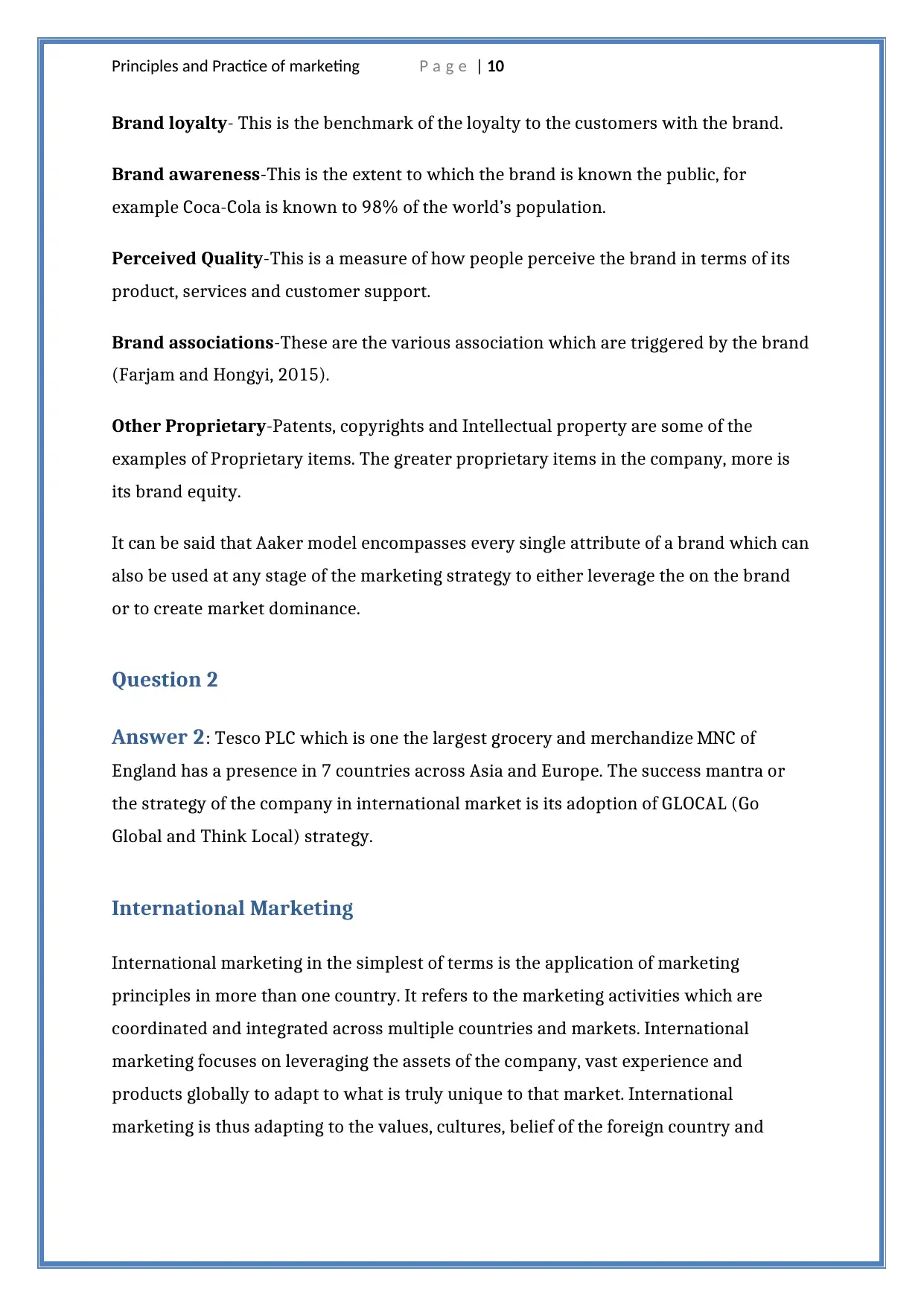
Principles and Practice of marketing P a g e | 10
Brand loyalty- This is the benchmark of the loyalty to the customers with the brand.
Brand awareness-This is the extent to which the brand is known the public, for
example Coca-Cola is known to 98% of the world’s population.
Perceived Quality-This is a measure of how people perceive the brand in terms of its
product, services and customer support.
Brand associations-These are the various association which are triggered by the brand
(Farjam and Hongyi, 2015).
Other Proprietary-Patents, copyrights and Intellectual property are some of the
examples of Proprietary items. The greater proprietary items in the company, more is
its brand equity.
It can be said that Aaker model encompasses every single attribute of a brand which can
also be used at any stage of the marketing strategy to either leverage the on the brand
or to create market dominance.
Question 2
Answer 2: Tesco PLC which is one the largest grocery and merchandize MNC of
England has a presence in 7 countries across Asia and Europe. The success mantra or
the strategy of the company in international market is its adoption of GLOCAL (Go
Global and Think Local) strategy.
International Marketing
International marketing in the simplest of terms is the application of marketing
principles in more than one country. It refers to the marketing activities which are
coordinated and integrated across multiple countries and markets. International
marketing focuses on leveraging the assets of the company, vast experience and
products globally to adapt to what is truly unique to that market. International
marketing is thus adapting to the values, cultures, belief of the foreign country and
Brand loyalty- This is the benchmark of the loyalty to the customers with the brand.
Brand awareness-This is the extent to which the brand is known the public, for
example Coca-Cola is known to 98% of the world’s population.
Perceived Quality-This is a measure of how people perceive the brand in terms of its
product, services and customer support.
Brand associations-These are the various association which are triggered by the brand
(Farjam and Hongyi, 2015).
Other Proprietary-Patents, copyrights and Intellectual property are some of the
examples of Proprietary items. The greater proprietary items in the company, more is
its brand equity.
It can be said that Aaker model encompasses every single attribute of a brand which can
also be used at any stage of the marketing strategy to either leverage the on the brand
or to create market dominance.
Question 2
Answer 2: Tesco PLC which is one the largest grocery and merchandize MNC of
England has a presence in 7 countries across Asia and Europe. The success mantra or
the strategy of the company in international market is its adoption of GLOCAL (Go
Global and Think Local) strategy.
International Marketing
International marketing in the simplest of terms is the application of marketing
principles in more than one country. It refers to the marketing activities which are
coordinated and integrated across multiple countries and markets. International
marketing focuses on leveraging the assets of the company, vast experience and
products globally to adapt to what is truly unique to that market. International
marketing is thus adapting to the values, cultures, belief of the foreign country and
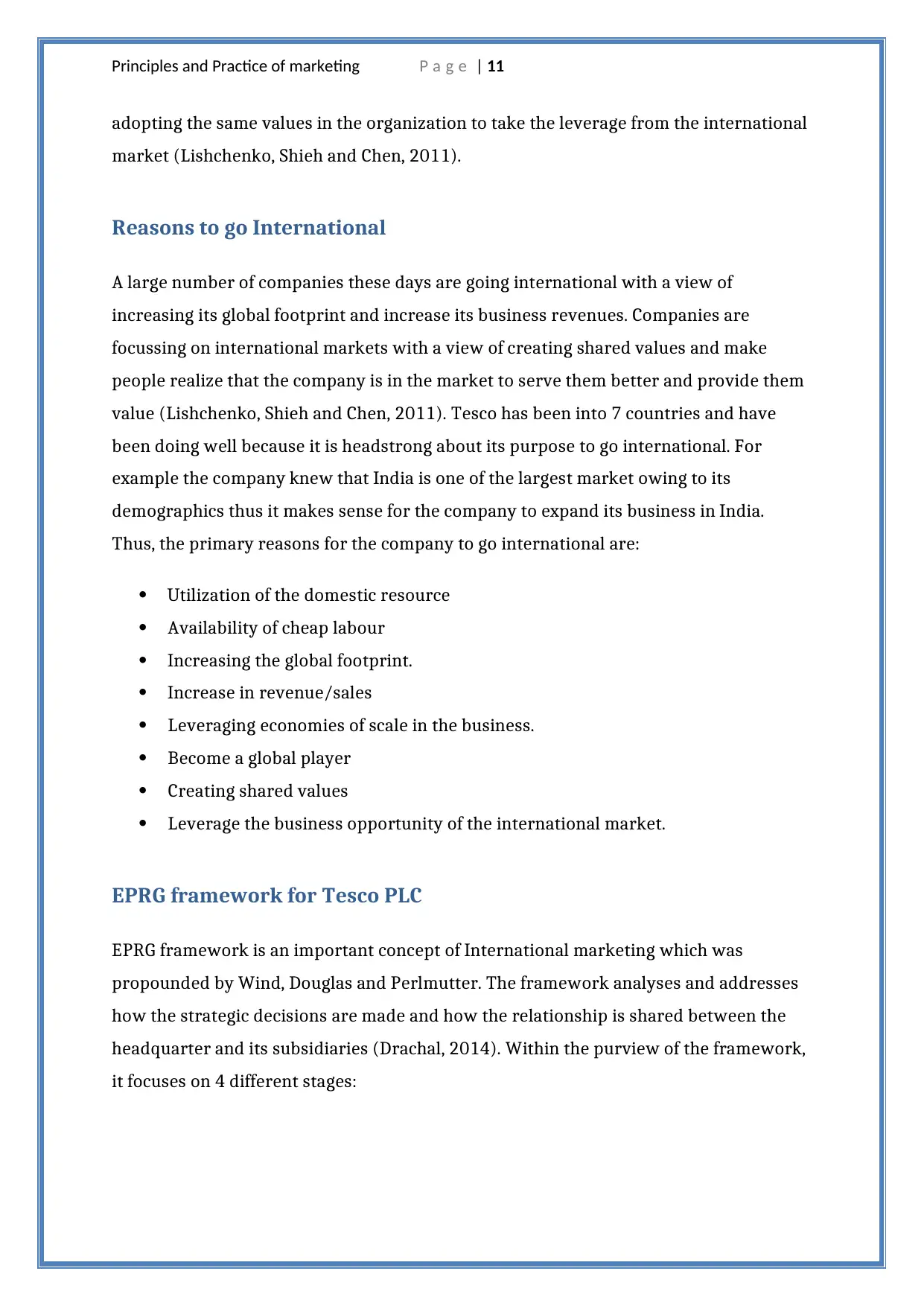
Principles and Practice of marketing P a g e | 11
adopting the same values in the organization to take the leverage from the international
market (Lishchenko, Shieh and Chen, 2011).
Reasons to go International
A large number of companies these days are going international with a view of
increasing its global footprint and increase its business revenues. Companies are
focussing on international markets with a view of creating shared values and make
people realize that the company is in the market to serve them better and provide them
value (Lishchenko, Shieh and Chen, 2011). Tesco has been into 7 countries and have
been doing well because it is headstrong about its purpose to go international. For
example the company knew that India is one of the largest market owing to its
demographics thus it makes sense for the company to expand its business in India.
Thus, the primary reasons for the company to go international are:
Utilization of the domestic resource
Availability of cheap labour
Increasing the global footprint.
Increase in revenue/sales
Leveraging economies of scale in the business.
Become a global player
Creating shared values
Leverage the business opportunity of the international market.
EPRG framework for Tesco PLC
EPRG framework is an important concept of International marketing which was
propounded by Wind, Douglas and Perlmutter. The framework analyses and addresses
how the strategic decisions are made and how the relationship is shared between the
headquarter and its subsidiaries (Drachal, 2014). Within the purview of the framework,
it focuses on 4 different stages:
adopting the same values in the organization to take the leverage from the international
market (Lishchenko, Shieh and Chen, 2011).
Reasons to go International
A large number of companies these days are going international with a view of
increasing its global footprint and increase its business revenues. Companies are
focussing on international markets with a view of creating shared values and make
people realize that the company is in the market to serve them better and provide them
value (Lishchenko, Shieh and Chen, 2011). Tesco has been into 7 countries and have
been doing well because it is headstrong about its purpose to go international. For
example the company knew that India is one of the largest market owing to its
demographics thus it makes sense for the company to expand its business in India.
Thus, the primary reasons for the company to go international are:
Utilization of the domestic resource
Availability of cheap labour
Increasing the global footprint.
Increase in revenue/sales
Leveraging economies of scale in the business.
Become a global player
Creating shared values
Leverage the business opportunity of the international market.
EPRG framework for Tesco PLC
EPRG framework is an important concept of International marketing which was
propounded by Wind, Douglas and Perlmutter. The framework analyses and addresses
how the strategic decisions are made and how the relationship is shared between the
headquarter and its subsidiaries (Drachal, 2014). Within the purview of the framework,
it focuses on 4 different stages:
⊘ This is a preview!⊘
Do you want full access?
Subscribe today to unlock all pages.

Trusted by 1+ million students worldwide
1 out of 19
Related Documents
Your All-in-One AI-Powered Toolkit for Academic Success.
+13062052269
info@desklib.com
Available 24*7 on WhatsApp / Email
![[object Object]](/_next/static/media/star-bottom.7253800d.svg)
Unlock your academic potential
Copyright © 2020–2025 A2Z Services. All Rights Reserved. Developed and managed by ZUCOL.





